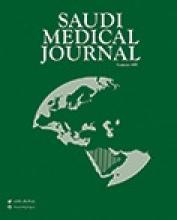To the Editor
I have read with interest the study of Bakarman et al,1 on the effect of an educational program on quality of life in patients undergoing hemodialysis in Western Saudi Arabia. I found the subject very important, however, I want to share some of my opinions especially on the methodology of the study. They said that they used the Short Form-36 (SF-36) but they did not give any reference about the manuscript on the validation of Arabic version of SF-36. Similarly, they described the necessary parameters for sample size calculation but they did not give any reference for the program if they did not calculate it by using the formulas by themselves. I realize that the calculation was made by using G*Power, if so, the reference should be written as the researchers, Faul F et al2 requested from all who use G*Power. For the sample size calculation, I believe that there is also one more issue. Might the calculation be made post hoc? Because it is not common to target to achieve a 84% of power. I believe this is a post hoc power for the determined parameters, for which I calculated “0.8421493” by G*Power.3,4 If I had been the reviewer of the study I had offer to use the CONSORT checklist which might be very useful for the presentation of the study. For example, I cannot understand the total of patients included in the study, how many were excluded for which reason, etc. Without giving this information, the reader can think that the researcher determined the criteria and included the first 50 to the intervention group and 50 to the control group. The design may be so, but it should be written as what it is performed. There are few issues as well, lack of information mostly, also on other presentations: They said that “Paired t test was used and the results are presented in Table 2.”, but on the bottom of the Table 2 it is written as “* Independent t-test, † Significance level at p<0.05”. There was no information on the standardization of the trainings of the trainers-an important bias source, routine information given to control group, etc.
Because of all of these methodological problems, I presume that these results should be cautiously interpreted.
Reply from the Author
We really appreciate valuable feedback from the reviewer. Reviewer highlighted some queries.
Translation validation
In the manuscript, we have not mentioned anywhere that SF-36 is translated into Arabic language, rather we said: “Patients undergoing hemodialysis were interviewed during their outpatient hemodialysis sessions and during their regular follow up clinical visits to the dialysis units.” It was an interview carried out by one member of the research team asking each patient and then filling the survey.
Sample size
We have not used G.Power for sample size calculations, we use PASS for calculation of sample size. Details can be verified form screenshot of the program (Figure 1).
Power and Sample Size Estimation details.
Typographical mistake
Yes, there is typographical mistake, paired t-test was wrongly mentioned, we are regretful for this mistake. It is Independent t-test as mentioned in footnote of the Table 2.
Training of the trainers
It was only one investigator of the research team who delivered all the education sessions aided by only one dietitian delivering the dietary aspects of the education program.
Marwan A. Bakarman
Department of Family and Community Medicine King Abdulaziz University Jeddah, Kingdom of Saudi Arabia
Student Corner
We invite students from a variety of medical disciplines to submit original contributions based on their supervised research.
The Student Corner of Saudi Med J aims to help students explore research opportunities and network with other peers and mentors in the same field.
Submission Guidelines
Submitted Abstracts should include the following:
Title should be descriptive
Author's names and affiliation(specify college level/year, academic degree of Senior Author)
Abstract must be structured and not more than 300 words
The following are the typical headings:
Objectives (background, why the study was done, specific aims)
Methods (setting, date of study, design, subjects, intervention and analysis)
Results (findings, data and statistical tests) and
Conclusion (general interpretation of results)
General Information on Abstract Submission
Submitted Abstracts should be co-authored by a Senior Supervisor
Abstracts will be reviewed by Student's Corner Section Editor
There is no fee to submit an Abstract
Ethical Approval should be provided
Non-indexed materials
- Copyright: © Saudi Medical Journal
This is an open-access article distributed under the terms of the Creative Commons Attribution-Noncommercial-Share Alike 3.0 Unported, which permits unrestricted use, distribution, and reproduction in any medium, provided the original work is properly cited.







